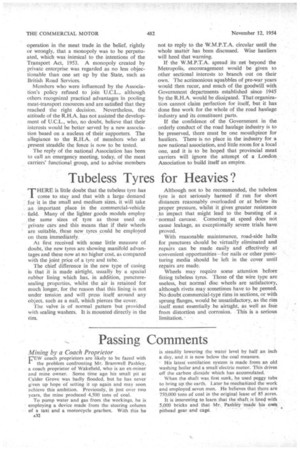Tubeless Tyres for Heavies?
Page 34

If you've noticed an error in this article please click here to report it so we can fix it.
T HERE is little doubt that the tubeless tyre has come to stay and that with a large demand for it in the small and medium sizes, it will take an important place in the commercial-vehicle field. Many of the lighter goods models employ the same sizes of tyre as those used on private cars and this means that if their wheels are suitable, these new tyres could be employed on them immediately.
At first received with some little measure of doubt, the new tyres are showing manifold advantages and these now at no higher cost, as compared with the joint price of a tyre and tube.
The chief difference in the new type of casing is that it is made airtight, usually by a special rubber lining which has, in addition, puncturesealing properties, whilst the air is retained for much longer, for the reason that this lining is not under tension and will press itself around any object, such as a nail, which pierces the cover.
The valve is of normal pattern but provided with sealing washers. It is mounted directly in the rim. Although not to be recommended, the tubeless tyre is not seriously harmed if run for short distances reasonably overloaded or at below its proper pressure, whilst it gives greater resistance _to impact that might lead to the bursting of a normal carcase. Cornering at speed does not cause leakage, as exceptionally severe trials have proved.
With reasonable maintenance, road-side halts for punctures should be virtually eliminated and repairs can be made easily and effectively at convenient opportunities—for nails or other puncturing media should be left in the cover until repairs are made.
Wheels may require some attention before fitting tubeless tyres. Those of the wire type are useless, but normal disc wheels are satisfactory, although rivets may sometimes have to be peened. No doubt commercial-type rims in sections, or with sprung flanges, would be unsatisfactory, as the rim itself must essentially be airtight, as well as free from distortion and corrosion. This is a serious limitation.




































































































